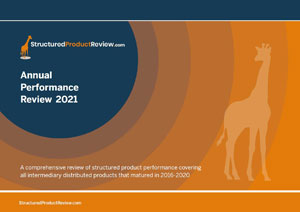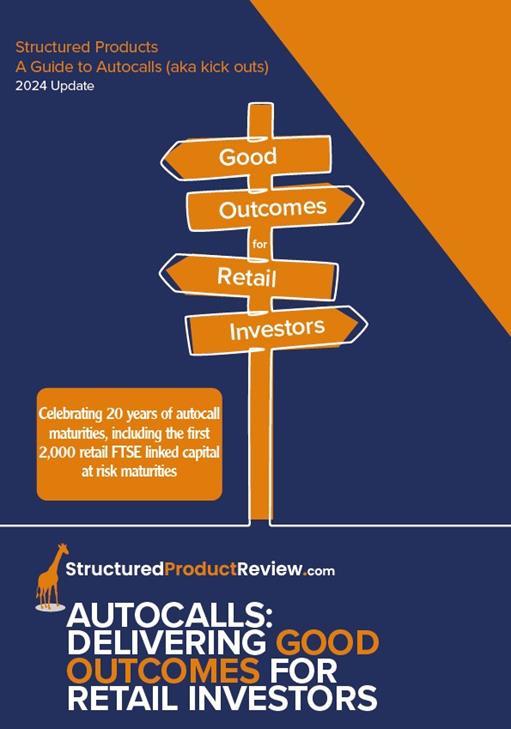Max Darer, Lowes Financial Management, 19/06/2024
The Bank of England Base Rate commenced 2022 at 0.25% and consistently rose to reach 5.25% in August 2023. We are assuming this to be, the terminal rate especially since financial markets are pricing in at least one rate cut before the end of the year and other major central banks having commenced their rate cuts. Here we will take a look at how capital-at-risk and deposit-based fixed income plan offers have fared in the last two years.
Reverse Convertible Notes/ Fixed Income plans are a specific type of structured investment that generate unconditional income over a fixed term. Capital is still placed at risk, albeit with a degree of downside protection through the incorporation of a capital protection barrier. To compensate for the risk of loss, fixed income plans pay interest that is greater than conventional debt with the same maturity and seniority from the same issuer– potentially making them attractive for income seeking investors.
The main risks stemming from Fixed Income Plans are first of all counterparty risk, in the event that the issuer becomes insolvent or defaults, a significant loss could result. Then there’s market risk, observed at the end of the term when falls in the underlying over the term could lead to losses in the event the market drops below the protection level.
Source: Bank of England and StructuredProductReview.com
The chart above shows the rise in the BoE’s Base Rate from the lows of 0.25% over the hiking period, reaching 5.25% in August 2023. For reverse convertibles this has directly resulted in an increase in the annual coupons offered – consistently higher than the base rate as well as the effective rate on 2 year + fixed rate term deposits. Intuitively this should always be the case given that investors are taking on a) market risk should at the end of the term the underlying falls drastically (often by more than 35%) and b) credit risk, the investor is reliant on the issuer remaining solvent/honouring the contract.
Not until late 2022 do we see the emergence of deposit based fixed income contracts that offer investors all the benefits of standard rev cons but without the underlying risks of a) severe market downturn and b) deposit taker default - investors are protected by the Financial Services Compensation Service (FSCS) limits (currently £85,000 per claimant per banking institution).
The effective interest on greater than 2-year fixed term deposits is included on the chart to demonstrate an opportunity cost of structured deposits – as can be seen the rates offered by fixed interest deposit-based plans have largely been superior to the effective rate albeit tight, thus demonstrating an uplift in interest for investors over opting for fixed term bonds.
The trend of annual income/interest is clearly following the Base Rate and we have likely already witnessed the highest paying of these types of structured products given we are expecting the Bank of England to cut rates this year. However, uncertainty remains over the ‘higher for longer’ stance that central banks seem to be taking to ensure that inflation is kept under control. Should this be the case we may see continued competitive rates for fixed income structured plans and deposits. Some of the latest Barclays fixed interest structured deposits offered c. 4.4% per annum vs. c. 5.5% per annum for putting capital at risk. Notably some capital at risk fixed income plans may have a kick-out feature that will trigger early maturity if the underlying is at or above, or some increased percentage of the initial level on annual observation dates.
Since 2022 to the time of writing, there has been just shy of 80 capital at risk fixed income plans offering average returns of 5.95% p.a with MB, Meteor and Walker Crips as the largest contributors to the market. Whilst the emergence of fixed income deposit plans has only been since November 2022, we have had 42 of such with average annual interest rates offered of 4.46% with MB and Barclays as the clear front runner.
Structured investments put capital at risk.
Also in this section
- How old is too old? Are structured products to die for?
- Product focus - October 2024
- Q3 2024 Issuance
- Q3 2024 maturity results
- A share of spread bets on steroids?
- Product focus - September 2024
- Maturities of the month - August 2024
- Right on time
- Product focus - August 2024
- Keep calm and zoom out
- 2,000 and counting
- Q2 2024 maturity results
- 20 years of autocall maturities
- Product focus - June 2024
- Fixed income or interest?
- Maturities of the month - May 2024
- The barrier debate - revisited
- Product focus - April 2024
- Maturities of the month - April 2024
- Time to call
- I don't believe markets are ever too high for Structured products!
- Notes on counterparty exposure
- Return of Nikkei
- Q1 2024 issuance
- Q1 2024 maturity results
- Structured Products – AAAAAGH!
- Hop in CIBC
- Re-enter Santander
- How to build a financial fortune - revisited
- Issuance in 2023
- Where's the risk?
- Questionable offerings
- Challenging the case against structured products - 'Loss of dividends'
- Navigating the investment landscape
- Challenging the case against structured products - Counterparty risk
- 6-year autocalls approaching final destination
- 1,750 FTSE capital at risk autocall maturities
- The leopard that changed her spots
- Q3 2023
- Challenging the case against structured products - Keydata
- Dilemmas for UK IFA's and the unique role of Structured Products
- 'High charges'
- Precipice bonds
- Intro
- FTSE 100 Contingent Income
- Indexing the indices
- Something different
- Investing through volatility
- 100 10:10s
- The best or worst?
- The 10%/25% 'Rule' that never was
- Structured products and the yield curve
- Fixed income: Capital at risk?
- Prospects for UK inflation - and fun with A.I!
- The Barrier Debate
- More Deposits for now
- Last of the Americans
- What if?
- Time heals all wounds, we hope...
- How to diversify portfolios using structured products?
- The Proof Is In The Pudding...
- Debunking Structured Misconceptions
- 1,500 FTSE Capital-at-Risk Autocall Maturities
- Q3 2022 Maturity Results
- What do we prefer?
- Deposits vs Capital ‘Protected’
- There’s time yet…
- Where did you invest your clients?
- A Six-Month Reflection
- Return of the Rev Con
- Happy 2nd Birthday FTSE CSDI
- Q2 2022 Maturity Results
- The best and worst yet still the best
- Critique my Suitability - Mariana 10:10 Plan June 2022 (Option 2)
- 10/10 for 55 10:10’s
- Q1 2022 Maturity Results
- 'How to build a financial fortune': a follow up
- Critique my Suitability - Mariana 10:10 Plan April 2022 (Option 2)
- 2021 Capital-at-Risk Autocall Maturity Review
- An unwelcome return...
- CSDI's First Birthday
- Bon Anniversaire
- Introducing the FTSE Custom 100 Synthetic 3.5% Fixed Dividend Index
- Q3 2021 Maturity Results
- Critique my Suitability - Mariana 10:10 Plan October 2021 (Option 2)
- Blurring the lines...
- Beware of false knowledge; it is more dangerous than ignorance
- Good news, bad news...
- Certainty is Certainly a Benefit
- Critique my Suitability - Mariana 10:10 Plan September 2021 (Option 2)
- A Twenty-Year Progression
- Q2 2021 Maturity Results
- Nine 8:8s Post Positive Returns in Falling Markets
- Critique my Suitability
- Q1 2021 Maturity Results
- Morgan Stanley’s Marvelous Maturity Medley
Current Products
We review the UK's retail structured investment sector, providing pertinent support for Professional Advisers and relevant research tools.
View all ⟶


